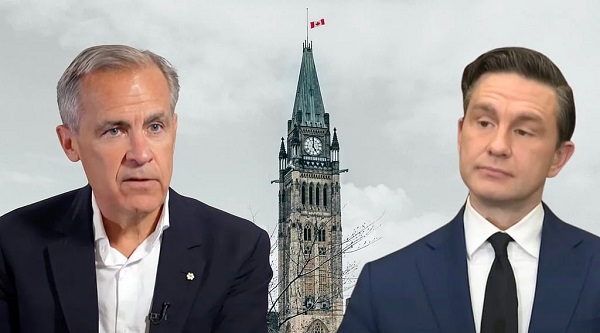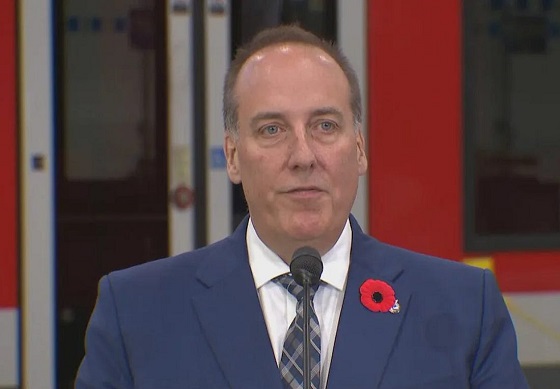Brownstone Institute
US should look to Canada to settle H-1B Visas issue

From the Brownstone Institute
By
President Trump has been very busy lately, driving leftist and Liberal Canadians utterly out of their minds by wickedly and hilariously trolling Prime Minister Justin Trudeau while simultaneously threatening a massive 25% tariff on the Canadian auto industry. With a solitary few taps of fingers on his phone, Trump cornered Canada by brewing an artisan Trumpian “threat to start some conversation” online. It went something like this: “Nice auto industry you got there. Would be a real shame if something happened to it!”
This “conversation starter,” which could also be rightly characterized as an existential death blow to the Canadian auto industry, forced Prime Minister Trudeau to hastily jet down to Mar-a-Lago. There, he unceremoniously flopped in his mission to mitigate damages, which has since been followed by the pilgrimage of several other notable Trudeau lightweights to continue the conversation. Maybe Mr. Wonderful will have better luck.
You could be forgiven if you thought the main lessons learned from this episode are that Canadians have a very fragile sense of humor, and that they bristle at being reminded how fully dependent the Canadian economy is on America. All of that is, of course, true. But if you thought that was the main event, you’d be wrong. The two main takeaways are that any industry that is being protected will, at some point, have an economic and policy moment of reckoning, along the lines of Herbert Stein: If something cannot go on forever, it will stop. And the second lesson is that it will likely play out in part, in real time on X. The Trump-Trudeau show, however, is just a shiny bauble. The real policy landmine in America is immigration, both legal and illegal.
This brings us to the H-1B visa issue in America, which is currently being “debated,” right in front of our eyes on X. On the surface, it seems to be a relatively simple philosophical debate; are you in favor of bringing in foreign workers for the jobs that Americans allegedly cannot do? Or do you favor policies that incentivize hiring Americans? Battle lines are even being drawn among conservative thought leaders and MAGA-adjacent personalities like Elon Musk, Vivek Ramaswamy, and others.
The public divide seems to be about being in favour of skilled immigration, or being anti-immigrant. But this framing is a distraction. The real issue, of course, is how writer Lee Smith puts it, which is that “…H-1B matters because it’s an effect of the core issue — indeed the reason DJT is POTUS — a political and corporate establishment that has waged a half-century long campaign to destroy the American middle class.”
Bingo. And this is where it behooves the Trump administration to learn from the failed Canadian experience with our H-1B visa equivalent: the Temporary Resident Permit or TRP.
Officially, the TRP gives status to non-citizens or permanent residents (the last step before citizenship) to be legally in Canada for a temporary purpose. This can include international students, tourists, or foreign workers. (The TRP does not apply to visa-exempt countries.)
Unofficially, the TRP is a literal cash cow for Canadian universities, and a veritable backdoor to get into Canada via an increasingly shifty diploma mill industry which contains a possible human trafficking element. There are also endless social media accounts that shamelessly explain how to game the system and remain in Canada. Plenty of Canadian corporations have benefitted from the influx of cheap labour, so much so that the Trudeau government has been forced to eat its hat on the TPR program and put new limitations in place, and not just on the TPR program but immigration in general. But the “temporary” population of Canada is now close to 10% of the Canadian population, and Canada has no real plan to get TPR permit holders to go home or to dissuade them from seeking asylum. Unsurprisingly, the temporary population simply doesn’t want to leave.
The final, glaring issue with both the H-1B and TRP is the undeniable fact that they are gateways to North America’s robust anchor baby (“birth tourism”) industry. In Canada, birth tourism, aided and abetted by almost nonexistent enforcement has added extra layers of stress to Canada’s already fiscally unsustainable socialized medical system.
“Temporary” programs in both Canada and America rarely benefit their existing populaces. More often than not, they habitually displace and punish the middle class. That’s a feature and not a bug. The H-1B acts in a similar fashion for skilled, white-collar workers. Moreover, as Milton Friedman famously said, “There is nothing more permanent than a temporary government program.” Here’s hoping the incoming Trump administration takes heed of Canada’s abject failure to rein in its permanent “temporary” population and reigns in the policies that more often than not, discriminate, decimate, and impoverish the native citizenry.
Brownstone Institute
Bizarre Decisions about Nicotine Pouches Lead to the Wrong Products on Shelves

From the Brownstone Institute
A walk through a dozen convenience stores in Montgomery County, Pennsylvania, says a lot about how US nicotine policy actually works. Only about one in eight nicotine-pouch products for sale is legal. The rest are unauthorized—but they’re not all the same. Some are brightly branded, with uncertain ingredients, not approved by any Western regulator, and clearly aimed at impulse buyers. Others—like Sweden’s NOAT—are the opposite: muted, well-made, adult-oriented, and already approved for sale in Europe.
Yet in the United States, NOAT has been told to stop selling. In September 2025, the Food and Drug Administration (FDA) issued the company a warning letter for offering nicotine pouches without marketing authorization. That might make sense if the products were dangerous, but they appear to be among the safest on the market: mild flavors, low nicotine levels, and recyclable paper packaging. In Europe, regulators consider them acceptable. In America, they’re banned. The decision looks, at best, strange—and possibly arbitrary.
What the Market Shows
My October 2025 audit was straightforward. I visited twelve stores and recorded every distinct pouch product visible for sale at the counter. If the item matched one of the twenty ZYN products that the FDA authorized in January, it was counted as legal. Everything else was counted as illegal.
Two of the stores told me they had recently received FDA letters and had already removed most illegal stock. The other ten stores were still dominated by unauthorized products—more than 93 percent of what was on display. Across all twelve locations, about 12 percent of products were legal ZYN, and about 88 percent were not.
The illegal share wasn’t uniform. Many of the unauthorized products were clearly high-nicotine imports with flashy names like Loop, Velo, and Zimo. These products may be fine, but some are probably high in contaminants, and a few often with very high nicotine levels. Others were subdued, plainly meant for adult users. NOAT was a good example of that second group: simple packaging, oat-based filler, restrained flavoring, and branding that makes no effort to look “cool.” It’s the kind of product any regulator serious about harm reduction would welcome.
Enforcement Works
To the FDA’s credit, enforcement does make a difference. The two stores that received official letters quickly pulled their illegal stock. That mirrors the agency’s broader efforts this year: new import alerts to detain unauthorized tobacco products at the border (see also Import Alert 98-06), and hundreds of warning letters to retailers, importers, and distributors.
But effective enforcement can’t solve a supply problem. The list of legal nicotine-pouch products is still extremely short—only a narrow range of ZYN items. Adults who want more variety, or stores that want to meet that demand, inevitably turn to gray-market suppliers. The more limited the legal catalog, the more the illegal market thrives.
Why the NOAT Decision Appears Bizarre
The FDA’s own actions make the situation hard to explain. In January 2025, it authorized twenty ZYN products after finding that they contained far fewer harmful chemicals than cigarettes and could help adult smokers switch. That was progress. But nine months later, the FDA has approved nothing else—while sending a warning letter to NOAT, arguably the least youth-oriented pouch line in the world.
The outcome is bad for legal sellers and public health. ZYN is legal; a handful of clearly risky, high-nicotine imports continue to circulate; and a mild, adult-market brand that meets European safety and labeling rules is banned. Officially, NOAT’s problem is procedural—it lacks a marketing order. But in practical terms, the FDA is punishing the very design choices it claims to value: simplicity, low appeal to minors, and clean ingredients.
This approach also ignores the differences in actual risk. Studies consistently show that nicotine pouches have far fewer toxins than cigarettes and far less variability than many vapes. The biggest pouch concerns are uneven nicotine levels and occasional traces of tobacco-specific nitrosamines, depending on manufacturing quality. The serious contamination issues—heavy metals and inconsistent dosage—belong mostly to disposable vapes, particularly the flood of unregulated imports from China. Treating all “unauthorized” products as equally bad blurs those distinctions and undermines proportional enforcement.
A Better Balance: Enforce Upstream, Widen the Legal Path
My small Montgomery County survey suggests a simple formula for improvement.
First, keep enforcement targeted and focused on suppliers, not just clerks. Warning letters clearly change behavior at the store level, but the biggest impact will come from auditing distributors and importers, and stopping bad shipments before they reach retail shelves.
Second, make compliance easy. A single-page list of authorized nicotine-pouch products—currently the twenty approved ZYN items—should be posted in every store and attached to distributor invoices. Point-of-sale systems can block barcodes for anything not on the list, and retailers could affirm, once a year, that they stock only approved items.
Third, widen the legal lane. The FDA launched a pilot program in September 2025 to speed review of new pouch applications. That program should spell out exactly what evidence is needed—chemical data, toxicology, nicotine release rates, and behavioral studies—and make timely decisions. If products like NOAT meet those standards, they should be authorized quickly. Legal competition among adult-oriented brands will crowd out the sketchy imports far faster than enforcement alone.
The Bottom Line
Enforcement matters, and the data show it works—where it happens. But the legal market is too narrow to protect consumers or encourage innovation. The current regime leaves a few ZYN products as lonely legal islands in a sea of gray-market pouches that range from sensible to reckless.
The FDA’s treatment of NOAT stands out as a case study in inconsistency: a quiet, adult-focused brand approved in Europe yet effectively banned in the US, while flashier and riskier options continue to slip through. That’s not a public-health victory; it’s a missed opportunity.
If the goal is to help adult smokers move to lower-risk products while keeping youth use low, the path forward is clear: enforce smartly, make compliance easy, and give good products a fair shot. Right now, we’re doing the first part well—but failing at the second and third. It’s time to fix that.
Addictions
The War on Commonsense Nicotine Regulation

From the Brownstone Institute
Cigarettes kill nearly half a million Americans each year. Everyone knows it, including the Food and Drug Administration. Yet while the most lethal nicotine product remains on sale in every gas station, the FDA continues to block or delay far safer alternatives.
Nicotine pouches—small, smokeless packets tucked under the lip—deliver nicotine without burning tobacco. They eliminate the tar, carbon monoxide, and carcinogens that make cigarettes so deadly. The logic of harm reduction couldn’t be clearer: if smokers can get nicotine without smoke, millions of lives could be saved.
Sweden has already proven the point. Through widespread use of snus and nicotine pouches, the country has cut daily smoking to about 5 percent, the lowest rate in Europe. Lung-cancer deaths are less than half the continental average. This “Swedish Experience” shows that when adults are given safer options, they switch voluntarily—no prohibition required.
In the United States, however, the FDA’s tobacco division has turned this logic on its head. Since Congress gave it sweeping authority in 2009, the agency has demanded that every new product undergo a Premarket Tobacco Product Application, or PMTA, proving it is “appropriate for the protection of public health.” That sounds reasonable until you see how the process works.
Manufacturers must spend millions on speculative modeling about how their products might affect every segment of society—smokers, nonsmokers, youth, and future generations—before they can even reach the market. Unsurprisingly, almost all PMTAs have been denied or shelved. Reduced-risk products sit in limbo while Marlboros and Newports remain untouched.
Only this January did the agency relent slightly, authorizing 20 ZYN nicotine-pouch products made by Swedish Match, now owned by Philip Morris. The FDA admitted the obvious: “The data show that these specific products are appropriate for the protection of public health.” The toxic-chemical levels were far lower than in cigarettes, and adult smokers were more likely to switch than teens were to start.
The decision should have been a turning point. Instead, it exposed the double standard. Other pouch makers—especially smaller firms from Sweden and the US, such as NOAT—remain locked out of the legal market even when their products meet the same technical standards.
The FDA’s inaction has created a black market dominated by unregulated imports, many from China. According to my own research, roughly 85 percent of pouches now sold in convenience stores are technically illegal.
The agency claims that this heavy-handed approach protects kids. But youth pouch use in the US remains very low—about 1.5 percent of high-school students according to the latest National Youth Tobacco Survey—while nearly 30 million American adults still smoke. Denying safer products to millions of addicted adults because a tiny fraction of teens might experiment is the opposite of public-health logic.
There’s a better path. The FDA should base its decisions on science, not fear. If a product dramatically reduces exposure to harmful chemicals, meets strict packaging and marketing standards, and enforces Tobacco 21 age verification, it should be allowed on the market. Population-level effects can be monitored afterward through real-world data on switching and youth use. That’s how drug and vaccine regulation already works.
Sweden’s evidence shows the results of a pragmatic approach: a near-smoke-free society achieved through consumer choice, not coercion. The FDA’s own approval of ZYN proves that such products can meet its legal standard for protecting public health. The next step is consistency—apply the same rules to everyone.
Combustion, not nicotine, is the killer. Until the FDA acts on that simple truth, it will keep protecting the cigarette industry it was supposed to regulate.
-

 Crime2 days ago
Crime2 days ago‘Modern-Day Escobar’: U.S. Says Former Canadian Olympian Ran Cocaine Pipeline with Cartel Protection and a Corrupt Toronto Lawyer
-

 National17 hours ago
National17 hours agoPsyop-Style Campaign That Delivered Mark Carney’s Win May Extend Into Floor-Crossing Gambits and Shape China–Canada–US–Mexico Relations
-

 COVID-1914 hours ago
COVID-1914 hours agoCovid Cover-Ups: Excess Deaths, Vaccine Harms, and Coordinated Censorship
-

 Bruce Dowbiggin15 hours ago
Bruce Dowbiggin15 hours agoBurying Poilievre Is Job One In Carney’s Ottawa
-

 Alberta1 day ago
Alberta1 day ago‘Weird and wonderful’ wells are boosting oil production in Alberta and Saskatchewan
-

 Alberta2 days ago
Alberta2 days agoAlberta on right path to better health care
-

 Artificial Intelligence2 days ago
Artificial Intelligence2 days agoLawsuit Claims Google Secretly Used Gemini AI to Scan Private Gmail and Chat Data
-

 Alberta1 day ago
Alberta1 day agoAlberta to protect three pro-family laws by invoking notwithstanding clause








